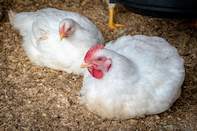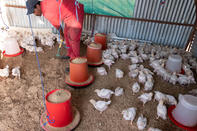Most poultry birds are raised on a layer of bedding spread over the top of the floor. When managed properly, bedding helps to improve bird welfare and health, by cushioning the floor and serving as insulation from the cold.

It also absorbs moisture, which not only helps to keep birds dry but reduces contact with faecal matter that otherwise might have caused blisters, skin burns and inflammation. Various factors should be considered when choosing bedding material.
Which material?

Cost is an important consideration, as it has a direct impact on the profitability of a poultry business. Pine shavings and sawdust are the most preferred material, but could be limited in supply and expensive in some areas. Rice hulls may also be a good material if it is available at an affordable price.
Farmers, however, should not be blinded by the price of material, as savings made by using better material could make up for initial price differences between products. The impact of transportation costs on the overall price should also be considered. Most farmers use material that is readily available near their farms.
Birds can generate tons and tons of manure, so the disposability of the material should also be taken into account. Poultry litter – the mixture of bedding, manure and feathers – makes for rich compost material. Some farmers sell it as fertiliser, while others use it to boost soil fertility in their own vegetable gardens or pastures.
To be used as fertiliser, the bedding material should be biodegradable, in other words break down easily. While it is against the law to sell poultry litter as animal feed, the material is a relatively cheap non-protein nitrogen source for ruminants, such as cows, goats and sheep. The litter should be properly treated and processed to avoid health risks to ruminants or people.
It also should be easily digestible, free from glass, metals, toxins, foreign materials, dead carcasses, rodents and animal protein. Animals that receive the feed should be vaccinated preventatively against botulism, a fatal bacterial disease that causes muscle paralysis of infected animals. When looking at the physical properties of the material it should be:
- Highly absorbent and quick to dry. Wet litter will cause breast blisters, foot burns and rejected carcass. It also emits excessive ammonia and encourages the growth of harmful bacteria and fungi. The ideal is to maintain litter moisture levels between 21 and 25 percent. If it sticks together like a ball, it is too wet. If it adheres slightly it is alright. If it does not adhere at all, it is too dry.
- Light and easy to manage. The material would have to be regularly turned and managed in a way to prevent caking and excessive moisture.
- Free from toxins, glass, metals and other foreign material that pose health hazards. Some hardwoods contain fungi that is harmful to the birds. Peanut hulls is an inexpensive bedding material in peanut producing areas, but may contain harmful pesticides.
- Good insulation properties to shelter chicks from the cold. Sand is not a good option as it has poor thermal conductivity and birds struggle to move in it when it is spread too deeply.
- Medium sized particles. Anything larger than 30 mm, such as crushed maize cobs and wood chips could hurt birds’ feet and breasts and ultimately result in carcass downgrades. Material smaller than 2 mm, such as sawdust or finely chopped wheat, straw or hay, on the other hand, produces dust that is harmful to bird and human health.